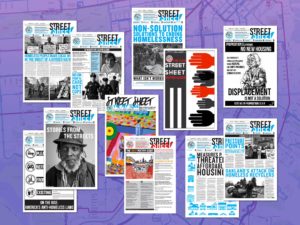by Lukas Illa
In a deeply emotional and well attended hearing, the San Francisco Planning Commission began review of the newly proposed luxury housing complex at 2588 Mission St., on the corner of 22nd Street.
What is currently a grassy, empty lot was once the site of rent-controlled housing for over 60 people and 26 businesses, until a devastating fire in 2015 destroyed the property, displacing the residents and business and killing 38-year-old Mauricio Orellana. While the Fire Department ultimately determined the cause of the fire to be electrical failings, the owner of the property, Hawk Lou has long been accused of gross negligence for the building’s blocked fire exits and broken fire alarms; many have even suspected and suggested to the media that Lou was responsible for the fire to make way for greater profits from future development.
At the February 6 commission meeting, hundreds of Mission residents and housing advocates spoke out against the proposed building, which activists coined as “La Muerte,” or “The Monster”—181 new market-rate condo units, of which only 19 are affordable housing units, barely meeting the minimum required under state law.
For years, anti-displacement activists have argued that the predominantly Latinx residents and businesses should be granted the right to return, and that the site should be 100% affordable housing.
“It is the responsibility of this city to aggressively pursue the rights of protected classes— formerly housed, renting business, holding jobs—at this site, and to ensure that any project proposed here is serving the protected classes of this community to uphold their legal obligation to affirmatively further fair housing,” Larisa Pedroncelli of United to Save the Mission said
The obligation Pedroncelli was referring to is the City’s “housing element,” which serves as San Francisco’s eight-year plan for meeting its housing requirements. Its most recent update in 2022 saw the explicit inclusion of racial equity considerations, including the aims to “repair the harms of racial and ethnic discrimination against American Indian, Black, and other people of color; foster racially and socially inclusive neighborhoods through equitable distribution of investment and growth; and provide sufficient housing for existing residents and future generations for a city with diverse cultures, family structures, and abilities.”
However, the commission’s ability to curtail the project by conforming it to the housing element’s standards has been stymied by a change in state law.
California’s Housing Accountability Act (HAA) and the State Density Bonus Law (SDBL) both prevent the local housing element from being used in any part to modify or reject the proposed use for the site. It significantly hampers any substantive changes the commission could assert in its discretionary review of the development plans.
This paradox infuriated both the public commenters and commissioners alike.
“[HAA and SDBL have] created a situation, where—I think—we have a lot less room to maneuver in very bad situations like this, in a project with a history like this one does,” said commissioner Derek Braun.
“This thing that you are creating is death for our community,” a representative of Latinx day laborers added during public comment.
Yet the commissioners signaled that the project will most likely continue as is, due to the restrictions placed upon the body by state law—much to the dismay of residents and community organizations urging the commission to overturn the project and slate it for fully affordable housing.
Still, SF Planning Commissioner Theresa Imperial charged her colleagues to “find the courage to [sic] protect our most vulnerable communities … I think it’s time for us to make that kind of stand.”
Final approval for 2588 Mission St. is scheduled for April.

